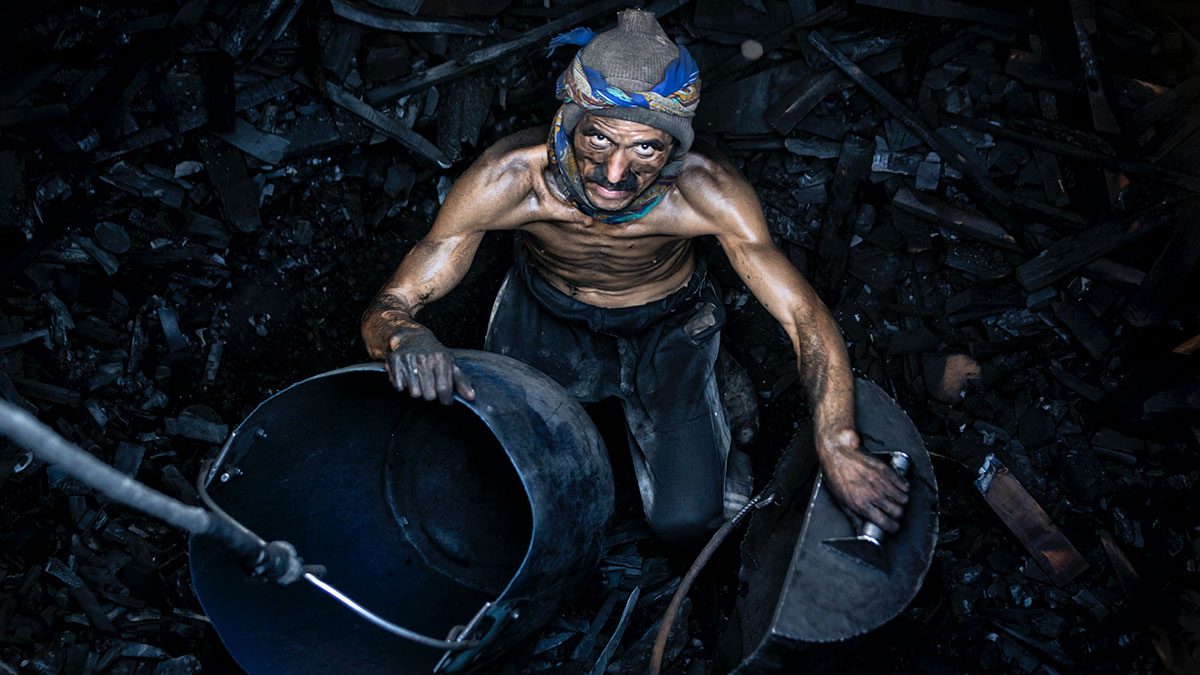National Public Radio (NPR) and the Centre for Public Integrity (CPI) teamed up to produce a special investigative report on the increased incidence of black lung disease in coal miners. The results of their combined investigations were released on the NPR’s radio stations on July 9–10, 2012 and broadcast on Public Broadcasting Systems (PBS) television on July 9, 2012.
The investigation found that black lung disease in miners had quadrupled since the 1980s and doubled since June–July 2002. This doubling coincides with an increase of 600 hours in the work year of the average miner since 2002.
The NPR/CPI investigation focused on mining in West Virginia, Virginia, and Kentucky and found that over 10,000 miners had died of black lung disease and ‘massive fibrosis’ (the most advanced and deadly form of black lung disease) between 1985 and 1994 and that over 2,000 had died from the same causes in West Virginia alone.
There is no treatment for black lung disease. Many victims report that at its ‘massive fibrosis’ stage they can either eat or breathe, but not both at the same time. One victim interviewed on NPR and PBS said that he could not even hold his two-year-old grandson for more than a minute or so before oxygen deprivation set in and he had to set the child down. It was too exerting for him.
The coal seams in existing mines are thinner now than they were decades ago, and mining companies are extracting coal seams down to one inch thick. These seams are often embedded in quartz rock that has a high silica content. As deadly as coal dust is in itself, the dust produced from extracting these tiny seams is even more deadly.
Hiding the Dust
In 1960 Congress passed a law to protect the health of coal miners by regulating coal dust levels in mines. The Big Coal lobby and the elected politicians of the area (and beyond) had a hand in weakening safety protections in the law that was actually passed. Senator Robert Byrd (known as ‘the coal miner’s friend’) helped weaken the law for economic reasons – to make it cheaper for mining companies to comply and ensure that Big Coal would continue to contribute money to his many, many re-election campaigns. The Senator had a vested interest in protecting coal industry profits. All politicians want corporate profits to be large.
The law that finally passed to protect coal miners from the worst abuses of the industry was weak, flawed, and had many loopholes. The law was weak as it put in place the concept of self-policing by the company itself. It was flawed because inspectors were not allowed to enter the mines while production was going on (which was 24 hours a day) without the prior consent of the mining company.
One of the loopholes is that when the coal dust samples collected by the industry do not agree with the coal dust samples collected by regulatory inspectors, industry is granted what in golf is called a ‘Mulligan’ — a replay — but one no opponent would ever accept. The company is allowed to collect dust samples from five locations chosen by itself and calculate an average that becomes the definitive coal dust concentration to compare with the figure derived from the samples collected by the government regulatory inspector. For some reason, the concentrations determined by the coal companies and those calculated by the inspectors very often do not agree! The coal companies, of course, come up with lower figures.
Mining companies have still been cited with more than 53,000 violations during the last decade. For some strange reason fewer than 1,000 of them resulted in court action!
Dust pumps were installed to collect coal dust samples at the coal face, often mounted on the mining machine itself. At a Massey Mine the bosses directed that plastic bags should be put over the intake of the pump to cheat the test. The workers were told that if the concentrations of coal dust were found to be too high the mine would be closed and “they’d be out of work.”
There is one tiny and tarnished silver lining. The Patriot Coal Company filed for bankruptcy on July 9, 2012. The tarnish is that Patriot miners are now without jobs.
Workers Are Cheap
The reader may well ask why coal-mining companies would deliberately cheat on safety tests and regulations designed to protect the health (and thus the productivity) of their own workers. Big business is in business to make the greatest profit possible. Workers are expendable and can easily be replaced from the pool of the unemployed. Even during ‘good times’ 3.5% to 5% of the workforce are unemployed. During times of high unemployment (like now) a lost worker is even easier to replace and may even be got at a lower wage rate than the lost worker was being paid. Big business is the product and ultimate consequence of the capitalist system.
Capitalism demands that companies grow their profits or lose out and die, to be taken over by more competitive companies. Competition, under the neoliberal ethos in vogue for the past 35–40 years, means upping productivity (through technology and/or getting workers to do more work in a shorter span of time) and cutting costs, the largest cost being the labor bill, i.e., reducing wages.


The capitalist system in its current form confounds many older folks who remember the capitalism-with-a-human-face of the Keynesian phase of capitalist development, when wages were tied to worker productivity. It also confounds younger workers, but for different reasons. Younger folks born in the last forty years have experienced the rise of neo-liberalism as an inevitable progression, an economic necessity, almost a natural law.
In the capitalist world of today, the worker class hears big business bosses and corporate CEOs, economic experts, and even the workers’ own union bosses proclaiming that ‘we’re all in it together’ and ‘we’ve got to do more with less.’ The worker class hears nothing of viable alternatives to the rat race that has taken over their lives. They just keep plugging along thinking TINA — There Is No Alternative.
The bosses, CEOs, economists, and union bosses, all committed to and doing just fine by the system, say that the status quo is natural, moral, and efficient on its own and that the ‘free market’ system can only function at its highest potential if government stays out of the market. Otherwise it won’t be ‘free’ to fairly distribute its blessings to those who work hard and play by the rules.
Destroying the Environment
Such are the health consequences for those directly involved in the extraction of coal. What are the consequences of coal for the health of the geosphere and biosphere that make up our environment?
A report in the Annals of the New York Academy of Sciences entitled ‘Full Cost Accounting for the Life Cycle of Coal’ was released in February 2011 and given public attention on the NPR programme Science Friday. The report was produced by scientists from Harvard Medical School, Harvard School of Public Health, West Virginia University, Boston University of Public Health, Washington State University, the Gund Institute for Ecological Economics, the University of Vermont, and other institutions.
According to the report, each stage in the life cycle of coal — extraction, transport, processing, and combustion — generates a waste stream and carries multiple hazards for health and the environment. These costs are external to the coal industry and are thus often considered ‘externalities.’ The authors estimate that the life cycle effects of coal and the waste it generates are costing the US public from one third to over one half of a trillion dollars a year. Moreover, many of these so-called externalities are cumulative. Accounting for the damage done doubles or even triples the real cost of generating a unit of electricity from coal, making wind, solar, and other forms of non-fossil-fuel power generation, as well as investments in efficiency and electricity conservation, economically competitive.
Greenhouse Gas Emissions
The authors of the report found that burning coal produces 50% more emissions of carbon dioxide (CO2 — the main greenhouse gas) than combustion of an equivalent amount of oil and double the CO2 emissions from burning an equivalent amount of natural gas. In addition, coal contains mercury, lead, cadmium, arsenic, manganese, beryllium, chromium, and other toxic and carcinogenic substances that are released into the environment during combustion. Finally, the crushing and processing of coal release tons of tiny particles every year that contaminate the water, air, and soil, with consequent negative impacts on public health and the biosphere.
Methane is also released in the process of coal mining. It is a greenhouse gas 25 times more powerful than CO2. Even when methane decays it yields CO2 — a lose-lose situation.
Mountaintop Removal
The coal industry makes wide use of Mountaintop Removal (MTR) in Appalachia (eastern Kentucky, West Virginia, and south western Virginia). To get to the coal inside a mountain, explosives blast away the summit, together with the forest covering it. The resulting rubble or ‘spoil’ is dumped into the valleys below.

MTR has been used at about 500 sites in four states (Kentucky, Virginia, West Virginia, and Tennessee), burying 2,000 miles of streams and despoiling 1.4 million acres of scenic natural terrain. In Kentucky alone there are 293 MTR sites, with over 1,400 miles of streams damaged or destroyed and 2,500 more miles polluted.
Coal Combustion Waste = Fly Ash
Coal Combustion Waste (CCW) — or fly ash, as it is commonly called — is produced in the process of coal combustion. It contains toxic chemicals and heavy metals — pollutants known to cause cancer, birth defects, reproductive disorders, neurological damage, learning disabilities, kidney disease, and diabetes.
ALEC, the American Legislative Exchange Committee, wrote what they call ‘model legislation’ that would define fly ash as ‘non- hazardous waste.’ ALEC is a front group run by elected Republican Party officials and Republican Party members.
Biodiversity
Globally, the rich biodiversity of the Appalachian headwater streams is second only to that of the tropics. The Southern Appalachian Mountains are home to the greatest variety of salamanders in the world, with 18% of all known species.
Transporting Coal
70% of all US rail traffic is devoted to transporting coal. The National Research Council found that in 2007 alone 246 people were killed in rail accidents during coal transportation, of whom 241 were bystanders and five railway workers.
Conclusion
Due to the $333–500 billions’ worth of externalities generated by the coal industry every year, with damage done by the coal industry amounting to an additional $1–1.5 trillion per year, coal mining would be a thing of the past were the US government, with its monopoly on violence, not in collusion with Big Business — in this case, the coal industry.
There is no such thing as a ‘free market’ — and never has been. Government, with its law-making, courts, standing army, and security forces and its self-sustaining monopoly on violence, is necessary to camouflage the tremendous inequality and disequilibrium between the social classes and create the deliberately misleading impression of a society of normal human relations.
If all of us, every working class person, were to just say no — and the military and police are working class people too — the means of production would pass into our hands and we could stop the insane production that destroys the world and has been destroying the world for over two hundred years now under the capitalist system.
The Libertarian Communist, No. 21, Winter 2013



